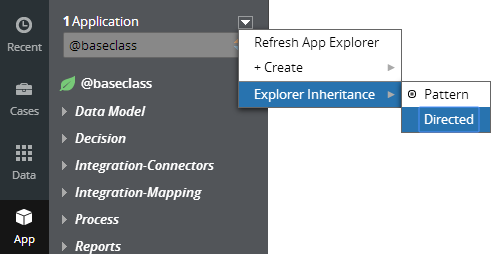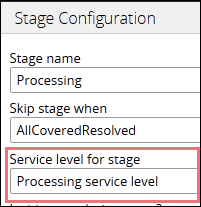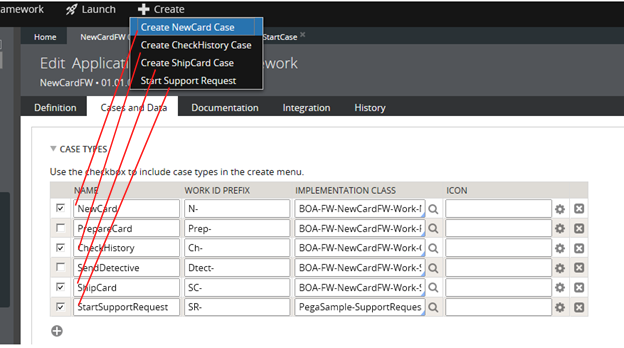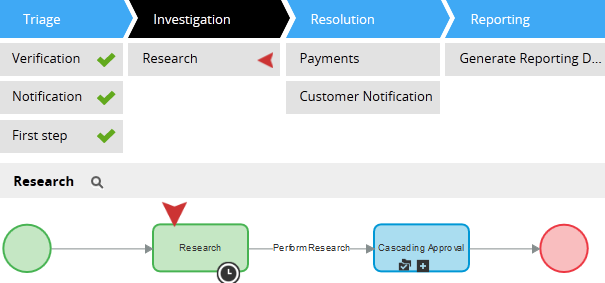Core Engine
Valid from Pega Version 7.1.4
This release contains fixes related to clipboard and declarative features, including data pages and autopopulate.
- A rule may be changed using Private Checkout, and then checked into a higher RuleSet Version for that RuleSet.
- Agents may now use a 24-hour time period for scheduling, as well as a 12-hour time period (which required the selection of AM or PM).
- Caching and performance have been enhanced.
- Declare expressions will work with embedded page lists when creating forms.
- Mandatory parameters on a data page can handle blank values.
- Properties may be auto-populated using a reference property which is created with a Property-Ref method in an activity.
- System will use "private edit" rules in developer's personal RuleSet when that rule overrides the "standard" rule available to all.
- The Page-Remove method will now remove Data Pages at the Thread level and the Requestor Level.
- When copying a page using the "Set" action on a data transform, the Declare Indexes defined on that data will be updated.
- When creating a data page, the Reload Once per Interaction checkbox can be checked to set the refresh strategy.
Top-level (named) pages may no longer be classless
Valid from Pega Version 7.1.1
Newly created top-level (named) pages may no longer be classless or have a blank pxObjClass property. This change can affect applications upgrading from versions prior to Pega 7 to the latest version, especially when:
- Application logic relies on a blank value in the pxObjClass property.
- An activity assumes a new top-level page is classless and explicitly sets pxObjClass in a Property-Set step.
- A data transform assumes a new top-level page is classless and explicitly sets pxObjClass using a Set action.
To avoid application failures, remove or update any logic that expects a blank pxObjClass. Where possible, use the new engine API that finds a page by both name and class:
findPageWithException(PageName, ClassName);
Activities and data transforms continue to create a top-level page when one does not exist. The class name is now derived from the Pages and Classes tab.
Designer Studio
Valid from Pega Version 7.1.4
Many refinements to the Designer Studio were made around performance and user experience. Based on feedback, we have made a number of bug fixes and strategic improvements that improve the overall user experience.
- The Developer Portal connects to the PDN's RSS feed without needing a DigiCert certificate for validation. The RSS feed is just headlines; to open and read any of the articles, users will still have to log into the PDN.
- Expression Builder has been enhanced to work with IE8.
- New applications built in Version 7.1 will automatically redirect users to the PRPC login page upon logout. A new template has been added, to allow developers to customize their applications to redirect users to a logout page, if they wish.
- Performance improvements were made when saving and validating rules.
- Performance of the Guardrails Dashboard has been improved.
- The display of circumstanced rules in Application Explorer has been enhanced.
Case Management
Valid from Pega Version 7.1.3
This release had a focus on extending key capabilities to improve the ease of configuration based on early adopter feedback. Improvements were made in run-time performance, especially in high volume situations with complex case configurations. A series of cosmetic changes and fixes are included.
- The Wait shape now supports dynamic references.
- Issues were addressed with the CreatePDF and the CascadingApproval Smartshapes.
- Attachments have been improved.
- Issues with the Create Case Type functionality were addressed.
- The Pega Pulse functionality has been improved, including its performance.
- When auditing a work item, History is now the default tab.
Designer Studio
Valid from Pega Version 7.1.3
Numerous usability improvements were made for this release. A group of cosmetic, functional, and performance enhancements were also included.
- Treegrid controls work more quickly in IE9 and IE10.
- On application ruleforms, the 5.4 "Place Properties on Thread Page" checkbox will work in 7.1.
- Message error handling has been improved.
- Log messages have been cleaned up.
- Connectors may now be used in Data Pages.
- Move Rules wizard has been enhanced to work in Version 7.1.
Guardrails compliance score
Valid from Pega Version 7.1.5
The Application Guardrails landing page has been enhanced to help you build more guardrail-compliant applications. Increase transparency and accountability on your projects by responding to the following compliance score metrics:
- A weighted compliance score (0-100) based on warnings, severity, and justification
- A percentage of compliant rules in your application
- Total number of rules in your application
- Total number of rules in your application with warnings (justified and unjustified)
Additional metrics include alert and interaction count trends over the last four weeks.
For more information, see Guardrails compliance score.
Directed inheritance view in Application Explorer
Valid from Pega Version 7.1.5
You can now specify which inheritance model is used to populate classes in the Application Explorer. From the top level menu, use the “Explorer Inheritance” option to choose between:
- Pattern: only display class names whose prefix matches the root node class name.
- Directed: first display classes that explicitly name the root node as the parent class; then display classes with pattern inheritance.

By default, the Application Explorer loads using Pattern inheritance.
Service levels for case stages
Valid from Pega Version 7.1.5
Service levels are available for stages in stage-based case management applications.
The service level starts when a case enters a stage and stops when it exits. The service level is defined in the Service level for stage field on the "Stage Configuration" dialog, which is accessed on the Case Designer Stages and Processes tab.

Alternatively, you can add a stage service level on the case type record's Stages tab.
Customize your starting flow list
Valid from Pega Version 7.1.5
The Designer Studio menu now populates the list of starting flows by referencing the case types that you select (including case types in Create Menu checkbox) on the application form's Cases and Data tab. The order of the case types on the tab dictates the order of flows that appear on the menu.

Previously, the menu displayed all starting flows in the current workpool. This new feature enables you to control which flows appear on the menu.
You can change the sort order by customizing the extension activity pySortStartingFlows. For example, you can sort the flows by their short descriptions.
Where-Am-I? includes stage and step progress
Valid from Pega Version 7.1.5
In stage-based case management applications, the Where-Am-I? display includes a read-only presentation of primary stage and step shapes. Green checkmarks indicate completed steps. A red arrow indicates the current step.


